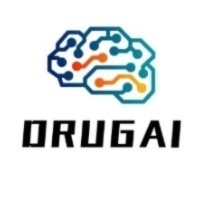DGL & RDKit | 基于Attentive FP可视化训练模型原子权重
DGL & RDKit | 基于Attentive FP可视化训练模型原子权重

DrugAI
发布于 2021-02-01 10:10:11
发布于 2021-02-01 10:10:11
文章被收录于专栏:DrugAI
DGL具有许多用于化学信息学、药物与生物信息学任务的函数。
DGL开发人员提供了用于可视化训练模型原子权重的代码。使用Attentive FP构建模型后,可以可视化给定分子的原子权重,意味着每个原子对目标值的贡献量。
基于Attentive FP可视化训练模型原子权重
环境准备
- PyTorch:深度学习框架
- DGL:基于PyTorch的库,支持深度学习以处理图
- RDKit:用于构建分子图并从字符串表示形式绘制结构式
- MDTraj:用于分子动力学轨迹分析的开源库
导入库
%matplotlib inline
import matplotlib.pyplot as plt
import os
from rdkit import Chem
from rdkit import RDPaths
import dgl
import numpy as np
import random
import torch
import torch.nn as nn
import torch.nn.functional as F
from torch.utils.data import DataLoader
from torch.utils.data import Dataset
from dgl import model_zoo
from dgl.data.chem.utils import mol_to_complete_graph, mol_to_bigraph
from dgl.data.chem.utils import atom_type_one_hot
from dgl.data.chem.utils import atom_degree_one_hot
from dgl.data.chem.utils import atom_formal_charge
from dgl.data.chem.utils import atom_num_radical_electrons
from dgl.data.chem.utils import atom_hybridization_one_hot
from dgl.data.chem.utils import atom_total_num_H_one_hot
from dgl.data.chem.utils import one_hot_encoding
from dgl.data.chem import CanonicalAtomFeaturizer
from dgl.data.chem import CanonicalBondFeaturizer
from dgl.data.chem import ConcatFeaturizer
from dgl.data.chem import BaseAtomFeaturizer
from dgl.data.chem import BaseBondFeaturizer
from dgl.data.chem import one_hot_encoding
from dgl.data.utils import split_dataset
from functools import partial
from sklearn.metrics import roc_auc_score代码来源于dgl/example
DGL开发人员提供了用于可视化训练模型原子权重的代码。
使用Attentive FP构建模型后,可以可视化给定分子的原子权重,意味着每个原子对目标值的贡献量。
def chirality(atom):
try:
return one_hot_encoding(atom.GetProp('_CIPCode'), ['R', 'S']) + \
[atom.HasProp('_ChiralityPossible')]
except:
return [False, False] + [atom.HasProp('_ChiralityPossible')]
def collate_molgraphs(data):
"""Batching a list of datapoints for dataloader.
Parameters
----------
data : list of 3-tuples or 4-tuples.
Each tuple is for a single datapoint, consisting of
a SMILES, a DGLGraph, all-task labels and optionally
a binary mask indicating the existence of labels.
Returns
-------
smiles : list
List of smiles
bg : BatchedDGLGraph
Batched DGLGraphs
labels : Tensor of dtype float32 and shape (B, T)
Batched datapoint labels. B is len(data) and
T is the number of total tasks.
masks : Tensor of dtype float32 and shape (B, T)
Batched datapoint binary mask, indicating the
existence of labels. If binary masks are not
provided, return a tensor with ones.
"""
assert len(data[0]) in [3, 4], \
'Expect the tuple to be of length 3 or 4, got {:d}'.format(len(data[0]))
if len(data[0]) == 3:
smiles, graphs, labels = map(list, zip(*data))
masks = None
else:
smiles, graphs, labels, masks = map(list, zip(*data))
bg = dgl.batch(graphs)
bg.set_n_initializer(dgl.init.zero_initializer)
bg.set_e_initializer(dgl.init.zero_initializer)
labels = torch.stack(labels, dim=0)
if masks is None:
masks = torch.ones(labels.shape)
else:
masks = torch.stack(masks, dim=0)
return smiles, bg, labels, masks
atom_featurizer = BaseAtomFeaturizer(
{'hv': ConcatFeaturizer([
partial(atom_type_one_hot, allowable_set=[
'B', 'C', 'N', 'O', 'F', 'Si', 'P', 'S', 'Cl', 'As', 'Se', 'Br', 'Te', 'I', 'At'],
encode_unknown=True),
partial(atom_degree_one_hot, allowable_set=list(range(6))),
atom_formal_charge, atom_num_radical_electrons,
partial(atom_hybridization_one_hot, encode_unknown=True),
lambda atom: [0], # A placeholder for aromatic information,
atom_total_num_H_one_hot, chirality
],
)})
bond_featurizer = BaseBondFeaturizer({
'he': lambda bond: [0 for _ in range(10)]
})
train_mols = Chem.SDMolSupplier('solubility.train.sdf')
train_smi =[Chem.MolToSmiles(m) for m in train_mols]
train_sol = torch.tensor([float(mol.GetProp('SOL')) for mol in train_mols]).reshape(-1,1)
test_mols = Chem.SDMolSupplier('solubility.test.sdf')
test_smi = [Chem.MolToSmiles(m) for m in test_mols]
test_sol = torch.tensor([float(mol.GetProp('SOL')) for mol in test_mols]).reshape(-1,1)
train_graph =[mol_to_bigraph(mol,
node_featurizer=atom_featurizer,
edge_featurizer=bond_featurizer) for mol in train_mols]
test_graph =[mol_to_bigraph(mol,
node_featurizer=atom_featurizer,
edge_featurizer=bond_featurizer) for mol in test_mols]
def run_a_train_epoch(n_epochs, epoch, model, data_loader,loss_criterion, optimizer):
model.train()
total_loss = 0
losses = []
for batch_id, batch_data in enumerate(data_loader):
batch_data
smiles, bg, labels, masks = batch_data
if torch.cuda.is_available():
bg.to(torch.device('cuda:0'))
labels = labels.to('cuda:0')
masks = masks.to('cuda:0')
prediction = model(bg, bg.ndata['hv'], bg.edata['he'])
loss = (loss_criterion(prediction, labels)*(masks != 0).float()).mean()
#loss = loss_criterion(prediction, labels)
#print(loss.shape)
optimizer.zero_grad()
loss.backward()
optimizer.step()
losses.append(loss.data.item())
#total_score = np.mean(train_meter.compute_metric('rmse'))
total_score = np.mean(losses)
print('epoch {:d}/{:d}, training {:.4f}'.format( epoch + 1, n_epochs, total_score))
return total_score
model = model_zoo.chem.AttentiveFP(node_feat_size=39,
edge_feat_size=10,
num_layers=2,
num_timesteps=2,
graph_feat_size=200,
output_size=1,
dropout=0.2)
train_loader = DataLoader(dataset=list(zip(train_smi, train_graph, train_sol)), batch_size=128, collate_fn=collate_molgraphs)
test_loader = DataLoader(dataset=list(zip(test_smi, test_graph, test_sol)), batch_size=128, collate_fn=collate_molgraphs)
loss_fn = nn.MSELoss(reduction='none')
optimizer = torch.optim.Adam(model.parameters(), lr=10 ** (-2.5), weight_decay=10 ** (-5.0),)
n_epochs = 100
epochs = []
scores = []
for e in range(n_epochs):
score = run_a_train_epoch(n_epochs, e, model, train_loader, loss_fn, optimizer)
epochs.append(e)
scores.append(score)
model.eval()导入用于分子可视化依赖库
import copy
from rdkit.Chem import rdDepictor
from rdkit.Chem.Draw import rdMolDraw2D
from IPython.display import SVG
from IPython.display import display
import matplotlib
import matplotlib.cm as cm定义可视化函数
- 代码来源于DGL库。
- DGL模型具有get_node_weight选项,该选项返回图形的node_weight。该模型具有两层GRU,因此以下代码我将0用作时间步长,因此时间步长必须为0或1。
def drawmol(idx, dataset, timestep):
smiles, graph, _ = dataset[idx]
print(smiles)
bg = dgl.batch([graph])
atom_feats, bond_feats = bg.ndata['hv'], bg.edata['he']
if torch.cuda.is_available():
print('use cuda')
bg.to(torch.device('cuda:0'))
atom_feats = atom_feats.to('cuda:0')
bond_feats = bond_feats.to('cuda:0')
_, atom_weights = model(bg, atom_feats, bond_feats, get_node_weight=True)
assert timestep < len(atom_weights), 'Unexpected id for the readout round'
atom_weights = atom_weights[timestep]
min_value = torch.min(atom_weights)
max_value = torch.max(atom_weights)
atom_weights = (atom_weights - min_value) / (max_value - min_value)
norm = matplotlib.colors.Normalize(vmin=0, vmax=1.28)
cmap = cm.get_cmap('bwr')
plt_colors = cm.ScalarMappable(norm=norm, cmap=cmap)
atom_colors = {i: plt_colors.to_rgba(atom_weights[i].data.item()) for i in range(bg.number_of_nodes())}
mol = Chem.MolFromSmiles(smiles)
rdDepictor.Compute2DCoords(mol)
drawer = rdMolDraw2D.MolDraw2DSVG(280, 280)
drawer.SetFontSize(1)
op = drawer.drawOptions()
mol = rdMolDraw2D.PrepareMolForDrawing(mol)
drawer.DrawMolecule(mol, highlightAtoms=range(bg.number_of_nodes()),
highlightBonds=[],
highlightAtomColors=atom_colors)
drawer.FinishDrawing()
svg = drawer.GetDrawingText()
svg = svg.replace('svg:', '')
if torch.cuda.is_available():
atom_weights = atom_weights.to('cpu')
return (Chem.MolFromSmiles(smiles), atom_weights.data.numpy(), svg)绘制测试数据集分子
该模型预测溶解度,颜色表示红色是溶解度的积极影响,蓝色是负面影响。
target = test_loader.dataset
for i in range(len(target)):
mol, aw, svg = drawmol(i, target, 0)
display(SVG(svg))
。。。

参考资料
1. https://github.com/dmlc/dgl/tree/master/apps/life_sci
2. https://github.com/dmlc/dgl/blob/master/python/dgl/model_zoo/chem/attentive_fp.py
3. https://pubs.acs.org/doi/full/10.1021/acs.jcim.9b00387
文 / 编辑:王建民
DrugAI
本文参与 腾讯云自媒体同步曝光计划,分享自微信公众号。
原始发表:2020-03-14,如有侵权请联系 cloudcommunity@tencent.com 删除
评论
登录后参与评论
推荐阅读
目录
